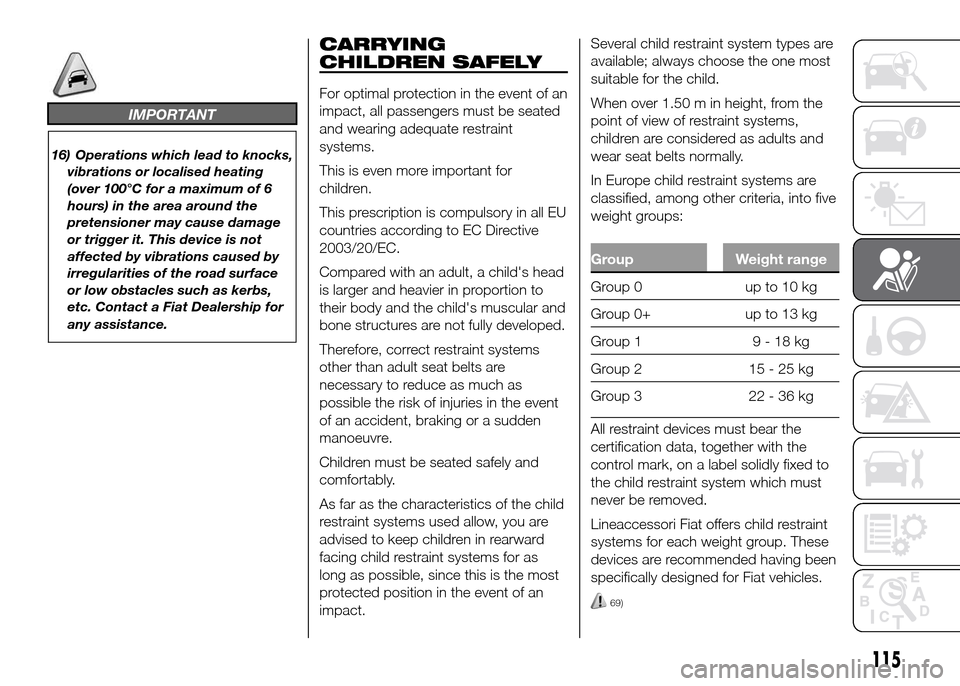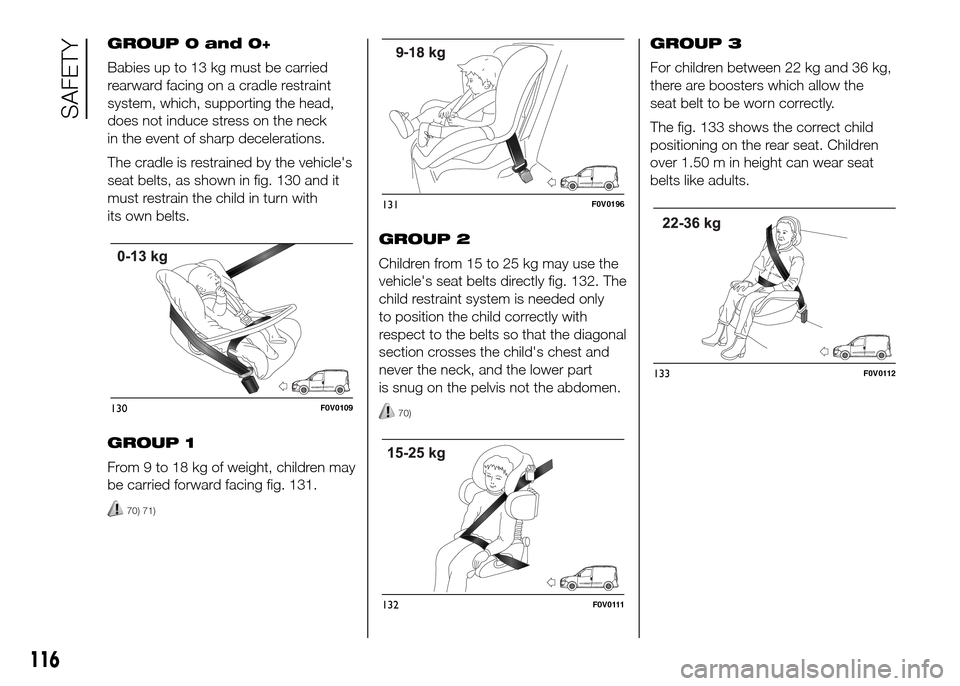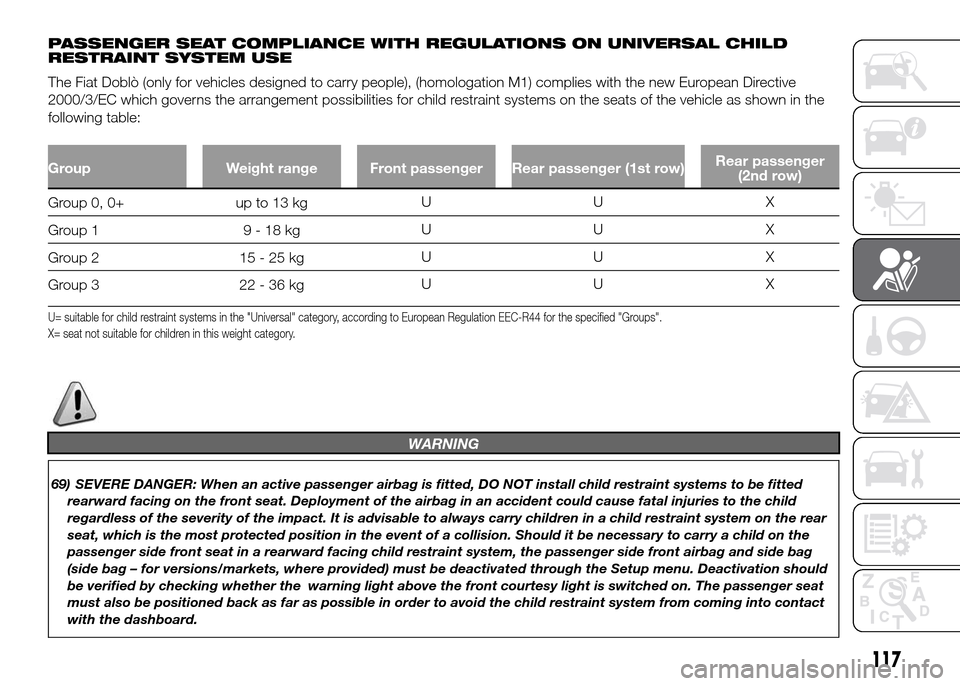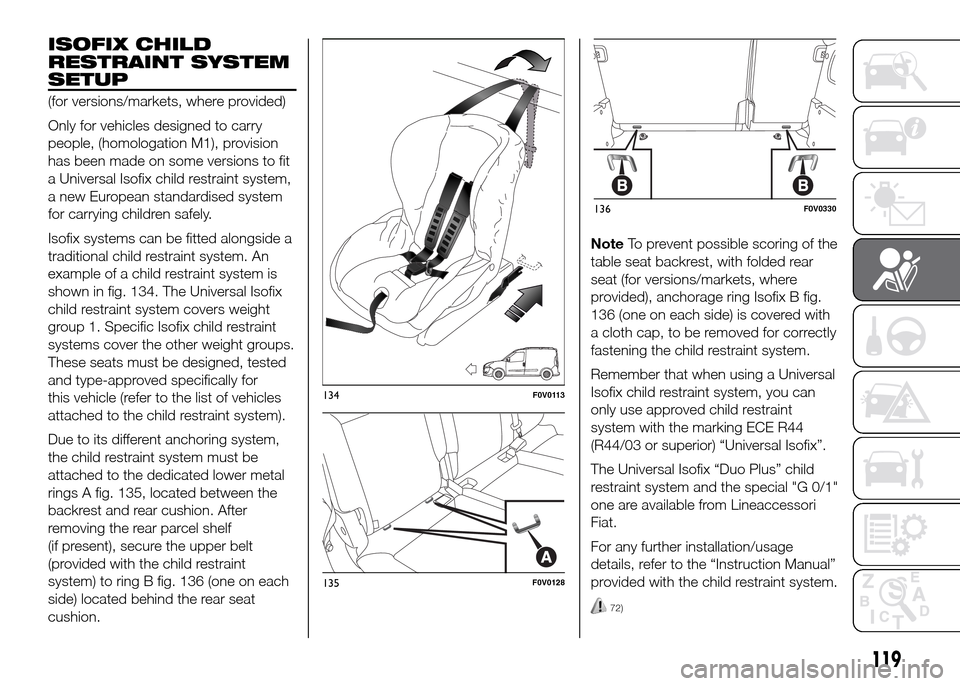Page 109 of 323
SAFETY
The chapter that you are about to read
is very important: it describes the
safety systems with which the car is
equipped and provides instructions on
how to use them correctly.ACTIVE SAFETY SYSTEMS ............106
ABS ................................................106
ESC (ELECTRONIC STABILITY
CONTROL) SYSTEM .......................108
OCCUPANT PROTECTION
SYSTEMS .......................................110
SEAT BELTS ...................................111
SBR SYSTEM .................................112
PRETENSIONERS...........................113
CARRYING CHILDREN SAFELY ......115
ISOFIX CHILD RESTRAINT
SYSTEM SETUP .............................119
FRONT AIRBAGS............................121
SIDE BAGS .....................................126
105
Page 114 of 323

For the correct operation of the ASR
system, the tyres must absolutely
be the same make and type on all
wheels, in perfect condition and, above
all, of the type, make and size specified.
FAULT INDICATIONS
In the event of a fault, the ASR will be
automatically switched off and the
warning light will appear
permanently on the instrument panel
along with a message on the
multifunction display, where provided
(see “Warning lights and messages”). In
this case, contact a Fiat Dealership as
soon as possible.
WARNING
58) Do not take unnecessary risks,
even if your vehicle is fitted with
an ESC system. Your driving style
must always be suited to the
road conditions, visibility
and traffic. The driver is always
responsible for road safety.
59) For the ESC and ASR systems to
function correctly, all four tyres
must be the same brand and type,
must be in excellent condition
and, above all, must be of the
prescribed type and size.
60) Do not take unnecessary risks,
even if your vehicle is fitted with
this system. Your driving style
must always be suited to the road
conditions, visibility and traffic.
The driver is always responsible
for road safety.
OCCUPANT
PROTECTION
SYSTEMS
The most important safety equipment
of the vehicle comprises the following
protection systems:
❒seat belts;
❒SBR (Seat Belt Reminder) system;
❒head restraints;
❒child restraint systems;
❒front airbags and side bags.
Read the information given the
following pages with the utmost care. It
is of fundamental importance that the
protection systems are used in the
correct way to guarantee the maximum
possible safety level for the driver and
the passengers.
122F0V0576
110
SAFETY
Page 119 of 323

IMPORTANT
16) Operations which lead to knocks,
vibrations or localised heating
(over 100°C for a maximum of 6
hours) in the area around the
pretensioner may cause damage
or trigger it. This device is not
affected by vibrations caused by
irregularities of the road surface
or low obstacles such as kerbs,
etc. Contact a Fiat Dealership for
any assistance.
CARRYING
CHILDREN SAFELY
For optimal protection in the event of an
impact, all passengers must be seated
and wearing adequate restraint
systems.
This is even more important for
children.
This prescription is compulsory in all EU
countries according to EC Directive
2003/20/EC.
Compared with an adult, a child's head
is larger and heavier in proportion to
their body and the child's muscular and
bone structures are not fully developed.
Therefore, correct restraint systems
other than adult seat belts are
necessary to reduce as much as
possible the risk of injuries in the event
of an accident, braking or a sudden
manoeuvre.
Children must be seated safely and
comfortably.
As far as the characteristics of the child
restraint systems used allow, you are
advised to keep children in rearward
facing child restraint systems for as
long as possible, since this is the most
protected position in the event of an
impact.Several child restraint system types are
available; always choose the one most
suitable for the child.
When over 1.50 m in height, from the
point of view of restraint systems,
children are considered as adults and
wear seat belts normally.
In Europe child restraint systems are
classified, among other criteria, into five
weight groups:
Group Weight range
Group0 upto10kg
Group 0+ up to 13 kg
Group 1 9 - 18 kg
Group 2 15 - 25 kg
Group 3 22 - 36 kg
All restraint devices must bear the
certification data, together with the
control mark, on a label solidly fixed to
the child restraint system which must
never be removed.
Lineaccessori Fiat offers child restraint
systems for each weight group. These
devices are recommended having been
specifically designed for Fiat vehicles.
69)
115
Page 120 of 323

GROUP 0 and 0+
Babies up to 13 kg must be carried
rearward facing on a cradle restraint
system, which, supporting the head,
does not induce stress on the neck
in the event of sharp decelerations.
The cradle is restrained by the vehicle's
seat belts, as shown in fig. 130 and it
must restrain the child in turn with
its own belts.
GROUP 1
From 9 to 18 kg of weight, children may
be carried forward facing fig. 131.
70) 71)
GROUP 2
Children from 15 to 25 kg may use the
vehicle's seat belts directly fig. 132. The
child restraint system is needed only
to position the child correctly with
respect to the belts so that the diagonal
section crosses the child's chest and
never the neck, and the lower part
is snug on the pelvis not the abdomen.
70)
GROUP 3
For children between 22 kg and 36 kg,
there are boosters which allow the
seat belt to be worn correctly.
The fig. 133 shows the correct child
positioning on the rear seat. Children
over 1.50 m in height can wear seat
belts like adults.
130F0V0109
131F0V0196
132F0V0111
133F0V0112
116
SAFETY
Page 121 of 323

PASSENGER SEAT COMPLIANCE WITH REGULATIONS ON UNIVERSAL CHILD
RESTRAINT SYSTEM USE
The Fiat Doblò (only for vehicles designed to carry people), (homologation M1) complies with the new European Directive
2000/3/EC which governs the arrangement possibilities for child restraint systems on the seats of the vehicle as shown in the
following table:
Group Weight range Front passenger Rear passenger (1st row)Rear passenger
(2nd row)
Group 0, 0+ up to 13 kgUU X
Group 1 9 - 18 kgUU X
Group 2 15 - 25 kgUU X
Group 3 22 - 36 kgUU X
U= suitable for child restraint systems in the "Universal" category, according to European Regulation EEC-R44 for the specified "Groups".
X= seat not suitable for children in this weight category.
WARNING
69) SEVERE DANGER: When an active passenger airbag is fitted, DO NOT install child restraint systems to be fitted
rearward facing on the front seat. Deployment of the airbag in an accident could cause fatal injuries to the child
regardless of the severity of the impact. It is advisable to always carry children in a child restraint system on the rear
seat, which is the most protected position in the event of a collision. Should it be necessary to carry a child on the
passenger side front seat in a rearward facing child restraint system, the passenger side front airbag and side bag
(side bag – for versions/markets, where provided) must be deactivated through the Setup menu. Deactivation should
be verified by checking whether the warning light above the front courtesy light is switched on. The passenger seat
must also be positioned back as far as possible in order to avoid the child restraint system from coming into contact
with the dashboard.
117
Page 122 of 323
70) The figures are indicative and for assembly purposes only. Fit the child restraint system according to the
instructions, which must be included.
71) Child restraint systems with Isofix attachment are available for a safe anchoring to the seat without using the
vehicle seat belts. Follow the assembly instructions carefully.
118
SAFETY
Page 123 of 323

ISOFIX CHILD
RESTRAINT SYSTEM
SETUP
(for versions/markets, where provided)
Only for vehicles designed to carry
people, (homologation M1), provision
has been made on some versions to fit
a Universal Isofix child restraint system,
a new European standardised system
for carrying children safely.
Isofix systems can be fitted alongside a
traditional child restraint system. An
example of a child restraint system is
shown in fig. 134. The Universal Isofix
child restraint system covers weight
group 1. Specific Isofix child restraint
systems cover the other weight groups.
These seats must be designed, tested
and type-approved specifically for
this vehicle (refer to the list of vehicles
attached to the child restraint system).
Due to its different anchoring system,
the child restraint system must be
attached to the dedicated lower metal
rings A fig. 135, located between the
backrest and rear cushion. After
removing the rear parcel shelf
(if present), secure the upper belt
(provided with the child restraint
system) to ring B fig. 136 (one on each
side) located behind the rear seat
cushion.NoteTo prevent possible scoring of the
table seat backrest, with folded rear
seat (for versions/markets, where
provided), anchorage ring Isofix B fig.
136 (one on each side) is covered with
a cloth cap, to be removed for correctly
fastening the child restraint system.
Remember that when using a Universal
Isofix child restraint system, you can
only use approved child restraint
system with the marking ECE R44
(R44/03 or superior) “Universal Isofix”.
The Universal Isofix “Duo Plus” child
restraint system and the special "G 0/1"
one are available from Lineaccessori
Fiat.
For any further installation/usage
details, refer to the “Instruction Manual”
provided with the child restraint system.
72)
134F0V0113
135F0V0128
136F0V0330
119
Page 124 of 323
SUITABILITY OF PASSENGER SEATS FOR ISOFIX CHILD RESTRAINT SYSTEM USE
The table below shows the different installation possibilities of Isofix child restraint systems on seats fitted with Isofix
anchorages in compliance with European standard ECE 16.
Weight groupChild restraint system
positionIsofix size class Rear side Isofix positions
Group 0+ up to 13 kgRearward facing EIL
Rearward facing DIL
Rearward facing CIL
Group1from9upto18kgRearward facing DIL
Rearward facing CIL
Forward facing BIUF
Forward facing BIIUF
Forward facing AIUF
IL: suitable for Isofix child restraint systems to be positioned forward facing, universal class (fitted with third upper mounting), approved for the relevant weight group.
IL
IUF: suitable for special Isofix type child restraint systems and approved for this type of vehicle.
120
SAFETY